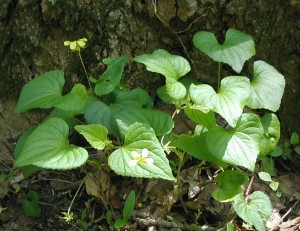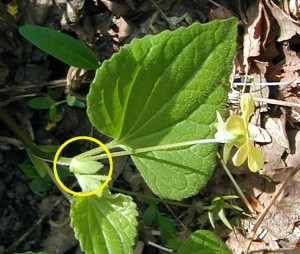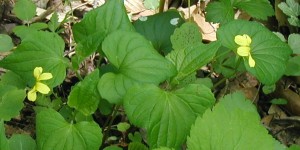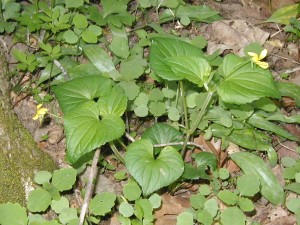Probably the first thing noticeable about yellow stemmed violets would be their heart-shaped leaves. The leaves branch off each other which gives a nice effect of producing a clump of heart-like leaves. Each leaf stands apart from the other as to make the heart-shaped outlines very obvious.

Stemmed violets have both flowers and leaves produced on the same stem. The differences between several yellow-stemmed violets come down to leaf shape.
The yellow stemmed violet that we have here is called the Downy Yellow Violet, Viola pubescens. Two identifying characteristics are first, the downy or softly hairy surface of the stems and leaves, and second, the toothed stipule, which is like a tiny leaf at the base of the heart-shaped leaves.

Note the yellow circle around the toothed stipule (hard to see the teeth in this image) and the downy hair on the leaves and stems.
The flowers appear differently depending on the angle that you view them at. Looking down on the violet you’ll see four petals, sideways you can see the spur and straight on gives you a look at the lined lower petal.


Yellow violets seem common in low-lying areas near creeks or wetlands. Blooming cohorts included white violets, the common blue violet, miterwort, wild ginger and wild stonecrop. Bloodroot and trout lily had already bloomed in this area. Photos were taken 30 April 2010 near the Day Use Area of Little Buffalo State Park in Newport, PA.
These pretty violets – and all members of Viola – are edible, but the Peterson Edible Plants Guide tells us that the yellow species may be mildly cathartic, which means that they may act as a laxative. The young leaves and flowers can be added to salads. The leaves can be used to thicken soups, boiled as a cooked green, or dried to make tea.
![Reblog this post [with Zemanta]](http://img.zemanta.com/reblog_e.png?x-id=820ba929-6f9e-4687-9d32-c3df1a8540cd)